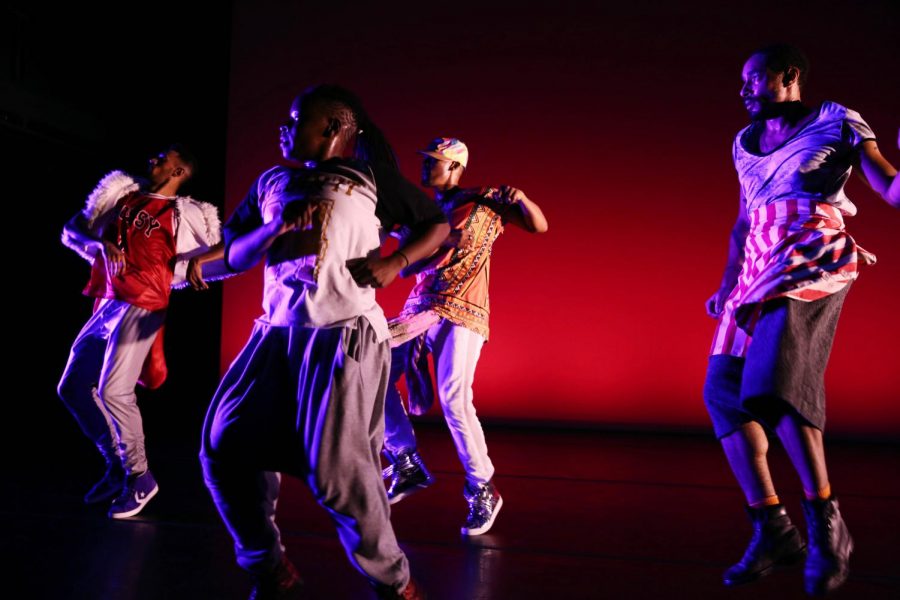Dance production celebrates black masculinity
Photo Courtesy of Julieta Cervantes
Dancers perform “Virago-Man Dem.” The production was created by University professor Cynthia Oliver to celebrate black masculinity. Two of the dancers, Duane Cyrus and Niall Jones, are University alumni whom Oliver recruited for the show.
Jan 16, 2018
Cynthia Oliver, a professor in the dance department and associate vice chancellor for research in the humanities, arts and related fields, has culminated her work, research and the passion of many years into a dance show. The show, “Virago-Man Dem,” is currently on tour around the country.
Oliver’s extensive dance background began when she was a child with her involvement in multiple dance styles. Growing up in the Virgin Islands also aided her in creating “Virago-Man Dem,” a show that celebrates black masculinity.
The show premiered at the Brooklyn Academy of Music in October and has since been on tour. The Daily Illini spoke with Oliver about the inspiration and work behind the show, her dance background and the importance of Virago-Man Dem in society.
Daily Illini: What is some of your background with dance?
Cynthia Oliver: When we left New York, where I was born, and returned to the Virgin Islands, my father’s place of birth, I was about eight and started dancing with Theatre Dance Inc., a project of Dutch dancer Atti van den Berg. Atti danced in Europe with the famed Kurt Jooss Tanz Theatre. She brought all kinds of artists to St. Croix and my first formal dancing with them was with a gentleman from Trinidad named Montgomery Thompson. I began dancing Afro-Caribbean dances with him and then was invited to ballet with Atti. Along with ballet and Afro-Caribbean dance, we danced in the environment and performed improvisation events outside in a variety of contexts. It was thrilling. I later went to college for dance. I had initially studied visual art and was going to go for architecture or engineering, but the dance schools recruited me and I have never looked back.
Get The Daily Illini in your inbox!
DI: Where did the inspiration for Virago-Man Dem come from?
CO: This work has been percolating for me for a very long time. But the urgency to do it now, at this moment, came because I felt there was a huge gap in what the American public is fed daily and what the realities are about the complexities and humanity of black men. I wanted to offer them more of black masculinity. Tenderness. Compassion. The laughter. The breadth of personalities, the depth of their hurt, of beauty that I know along with countless black communities, that we never get to see reflected back. So really this work for me is an act of love. It is my love offering to my son, to my father, grandfather, friends and all those amazing brothers who rarely get the props they deserve.
DI: What does the name “Virago-Man Dem” actually mean?
CO: The name came from the Caribbean as well. “Virago” is used to derogatorily address a woman who has characteristically masculine behaviors: bravery, forwardness, etc. and “dem” is used to denote plurality. So, “Virago-Man Dem” is an examination of a multiplicity of masculinities.
DI: What type of research and drafting helped you create your show?
CO: I essentially made the work via serial residencies over a two-year period. The Maggie Allesee National Center for Choreography at FSU was significant in making it possible for me to do the work. They offered me a Mellon Fellowship which supported the process for a number of years.
DI: How did you find the dancers for the show?
CO: Two, Duane Cyrus and Niall Jones, are U of I alum. I met them here, but because of a variety of reasons we didn’t work together while they were matriculated. I knew one day we would do something, so I invited them to do the piece once I knew that I wanted it to be a quartet. Then I put the word out to all my professional contacts that I was looking for two others. I found Jonathan Gonzalez that way. Then I had auditions in New York; I continued the word of mouth and one day it dawned on me that someone I had been talking with all along might be perfect if they were willing. So I asked Ni’Ja Whitson, a gender non-conforming performing artist, if they would be interested in joining us. Ni’Ja was the right fourth person. I had my group.
DI: How does the touring process for the show work?
CO: I have relationships with many of the theatres that we are touring too. They have been longtime supporters of my work and when I had a new work in the making, they offered to commission it and bring it to their theatres. Then there are newer venues. They may have been exposed to the work for a time or are recently introduced to it by social media, news feeds or their presenting peers. Some get support from organizations like the National Performance Network, which advocates for and supports a diversity of artists having their work seen by audiences around the country, and sometimes abroad, or the National Dance Project, which subsidizes touring across the country.
DI: Have there been many large challenges the show has faced?
CO: Making a new production is always challenging. The work has many moving parts and working with all of these folks requires a lot of schedule management. Thankfully, I have an amazing company manager who handles much of it for me. But it has also been an immense pleasure. The thing about making this kind of art is that I get to create the world I want to live in. And I live in and with it for the entire time we are making it through its touring life. That is a gift.






